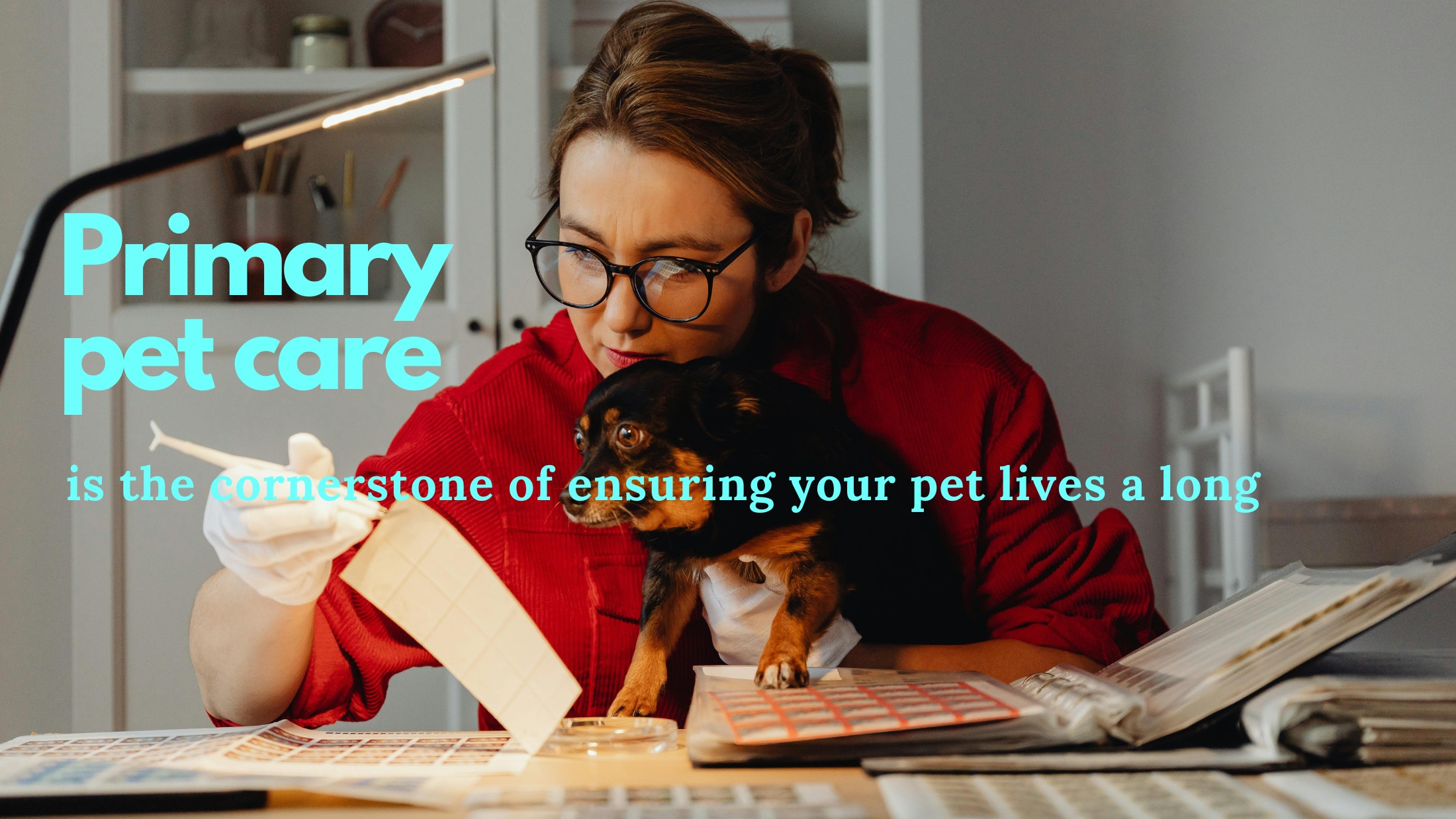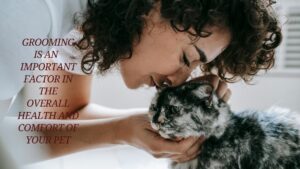Primary pet care is the cornerstone of ensuring your pet lives a long, healthy, and happy life. And as we take care of ourselves with routine health checkups and good nutrition, ‘primary pet care’ sets the groundwork to improve a poor adult life stage for a pet, whether juvenile or senior.
This is coming in the form of basic preventative care such as vet visits, adequate “pet nutrition”, grooming and mental stimulation, which all play into a pet’s physical and emotional well-being.
As part of a well-done “primary pet care” routine — avoiding serious health issues, like those preventable through a healthy diet, exercise and vaccination, and taking note of the little things, which can lead to bigger — it allows us to catch problems early and keep our pet healthy as long as possible.
Whether you’re a new pet owner or a seasoned pro, prioritizing a consistent and all-encompassing pet wellness routine makes sure that your pet’s needs are covered at every life stage. Taking a little proactive action now will save you time and money later and ensure your pet is flourishing in a safe, loving environment.
What is Primary Pet Care? A Comprehensive Overview
“Primary pet care” refers to the cornerstone of keeping your pet healthy and happy for life. It’s something more than emergency care or specialized treatments: It’s routine, preventive steps that help your pet live healthy, happy and for as long as possible.
This is what we refer to as some form of primary pet care, in this instance, a sort of proactive approach that focuses on educating your knowledge as a pet owner in the most basic of health topics, including “routine pet checkups”, vaccinations, “pet nutrition” and overall wellness for your furry or feathered companion.
At its core, “primary pet care” is creating a “pet wellness routine” that includes physical and emotional care. That includes regular vaccinations, flea and tick prevention and other “preventive pet care” measures to avoid your pet getting exposure to possible diseases.
Moreover, routine checkups aid in detecting any potential health problems, ensuring that you catch health issues before they advance.
An essential part of “primary pet care” is the right kind of balanced diet appropriate to your pet’s age, size and breed. Each pet has some special requirements in terms of nutrition that is integral for their proper functioning and overall well-being. The backbone for a healthy life — should be a nice diet and exercising which stops obesity and other diabetes and joint-related issues.
Early Intervention – The Key to Long-Term Health
When it comes to keeping your pet healthy in their primary pet care, early intervention is one of the most impactful methods to keep your pet healthy long-term. Early intervention when a potential health challenge is noted can prevent serious issues from developing later.
Early detection and proactive care are important components of a “pet wellness routine“, and implementing them can help keep your pet healthy as they age, giving them the best chance at living a longer and healthier life.
“For early intervention, routine pet checkups” are key. On these regular visits, your veterinarian can administer screenings and diagnostics that catch health problems before they become serious.
Blood tests, for instance, can reveal early signs of kidney or liver disease, and a dental examination can identify the first stages of dental disease that, if untreated, can develop into more serious health issues. This makes managing these issues and know how to treat it easier, the earlier the better.
One very important thing to keep in mind is “early intervention is preventive pet care“. Preventive measures, such as vaccinations, parasite control and others, are most effective when undertaken early in your pet’s life.
Scheduled vaccinations help prevent your pet from several potentially fatal diseases, and flea and tick treatments keep your pet free of these parasites that impact overall health.
Monitoring your pet’s behavior, appetite and overall physical condition is part of something called “primary pet care.” Any shift, even minor, can be an indication that something is amiss. Such signs could mean underlying health problems, such as a sudden drop in energy demands, eating habits, and weight.
Staying alert and catching issues early can help stop worse-from-happening scenarios in their tracks, and allow your vet to address worries quickly.
By embracing early intervention as part of your routine primary pet care, you minimize the risk of health consequences and ensure that your pet continues to bring you joy for years to come. Following these steps now can not only help nip problems in the bud but also provide your furry buddy a lifetime of health and happiness.
Pet Nutrition – Fueling a Happy, Healthy Life
One of the most important aspects of what we might refer to as “primary pet care” is that your pet be properly nourished. Pets need a good daily diet to keep their energy levels high, they can be healthy and feel great just as much as we do.
Pet nutrition encompasses more than picking the right food; it means knowing how nutrients influence your pet’s health throughout its life stages. A good diet is the cornerstone of your pet’s “pet wellness routine,” aiding everything at the muscle development to immune system function level.
“Primary pet care” means giving your pet a comprehensive, age-appropriate diet tailored to their needs. Puppies and kittens have different nutritional needs compared to adult or senior pets, which should be reflected in their food. Example: Ensuring the right balance of protein, fats, carbohydrates, vitamins, and minerals helps your pet thrive both physically and mentally.
Feeding them with a high-quality diet prescribed according to their breed, size, and level of activity can make a big difference when trying to prevent more common issues that pets suffer from such as obesity, digestive problems, or allergies.
Establishing “pet care basics,” such as portion control as well as consistent meal times, is key to maintaining a healthy weight and prevent overfeeding. Measuring daily meals and limiting treats can help avoid weight gain, a leading cause of ailments such as diabetes, arthritis or heart disease.
In addition to balanced meals, providing fresh, clean water at all times is vital for ensuring your pet stays hydrated and that all bodily processes are functioning normally.
One other component to “pet nutrition” in “primary pet care” is knowing how dietary needs change with age. For instance, foods that support joint health or have lower calories so senior pets can maintain a healthy weight can be lower in calories than their normal counterparts.
Likewise pets with special health issues, e.g., food sensitivities or kidney disease, may need a special diet to control these conditions. In these cases, collaborative effort between you and your vet regarding the best food and supplement plan is essential to ‘pet health management’.
Including proper nutrition among your “primary pet care” is vital to their living a long, happy, active life because nutrition is the fuel that keeps your pet’s life running smoothly. Setting them up for a lucky life helps them avoid most prevalent health problems and brings them happiness, ensuring that they eat healthy right from the start.
Regular Vet Checkups – Preventing Illness Before It Starts
Regular vet checkup is one of the pillars of “primary pet care”. Routine visits to the veterinarian are key to preventing illness before it occurs. Much like people, pets can have health problems that are not readily apparent. Catching a problem early and taking action can help prevent small issues from becoming big ones.
“Routine pet checkups” enable your veterinarian to assess your pet’s general health, checking for any indicators of illness or discomfort that you may overlook at home. On these checkups, the vet will perform a detailed physical examination to assess your pet’s overall health, including assessment of their weight, coat, skin, eyes, ears, and dentition.
These checkups help identify problems early, such as tooth and gum disease, arthritis or skin infections, that could become much worse if not treated.
And along with the physical exam, routine vet visits allow for updates on vaccinations, and if your pet isn’t current on vital preventives (flea, tick, and worm), your dog or cat can get those on the spot.
Preventive care is an important part of pet health care, and keeping on top of these treatments can help protect your pet from common diseases and parasites that might otherwise jeopardize their health.
And “routine pet checkups” are the ideal time for pet owners to bring up any behavioral changes or issues they may have noticed in their furry friends. If your pet is suddenly more lethargic, is eating less or seems uncomfortable, the vet can diagnose any underlying issues early on before they develop into serious health issues.
Following this approach to “pet health management” helps to prevent your pet from becoming ill, and is designed to keep them healthy, happy, and active for years to come.
Scheduling regular vet checkups as part of your routine “primary pet care” can save you time, money and stress in the long run by addressing health issues early, preventing costly treatments and increasing your pet’s overall well-being. By making these checkups a priority, you’re setting your pet up for a long, healthy, fulfilling life.
Grooming & Hygiene – The Often-Overlooked Aspect of Primary Care
While most pet owners get the idea of “primary pet care” regarding diet, exercise and routine vet care, grooming and ⏡hygiene tend to be neglected. But grooming is an important factor in the overall health and comfort of your pet.
Regular grooming is not just about keeping your pet clean and looking good — it is key to preventing a range of health issues and ensuring your pet feels their best.
Pet grooming includes brushing a pet’s coat, trimming the nails, cleaning the ears, and bathing and anal sac maintenance. Not only do these tasks make your pet look good and feel good, but they also prevent common health issues.
For instance, regular brushing removes loose fur, dirt and debris, minimizing risk of matting and attendant skin irritation or infection. It also stimulates those natural oils in the skin to help contribute to a healthier, shinier coat.
Ear cleaning is one of the most commonly neglected grooming tasks. Pets with floppy ears or long hair around their ears are especially susceptible to ear infections.
Over time, makeshift ear plugs can trap dirt and moisture inside the ear, providing the perfect conditions for bacteria and yeast to flourish without regular cleaning. Cleaning your pet’s ears on a regular basis helps to prevent infections, which potentially can lead to hearing loss or other serious health issues if left untreated.
Nail trimming is another important aspect of grooming. Long nails can lead to physical pain and injury to your pet. In severe cases, long nails can cause issues with the joints or prevent your pet from walking comfortably. Keep your pet’s mobility and comfort by maintaining a regular nail trim schedule.
Another aspect of grooming that many overlook is dental hygiene. Dental disease is prevalent in pets, but it can result in a host of serious health issues such as gum disease, tooth loss and even heart or kidney disease. Regular brushing or use of dental chews can help prevent buildup of plaque and maintain a healthy mouth in your pet.
Adding regular grooming to your “pet wellness routine” is an essential part of your pet’s overall health. Spending time with your pet on a regular basis helps identify any apparent health problems, such as skin infections, lumps, or parasites. Rendering grooming to your pet is indeed a best way to build ever stronger bonds and ensure their health and comfort.
When it comes to “primary pet care,” grooming must be top of mind. You are avoiding health problems, improving your pet’s Bonding and health, and providing them for some dirt to stay healthy and happy By doing consistent grooming. Whether you’re trimming their nails, brushing their coat or cleaning their ears, grooming is a crucial component of complete pet care.
Mental Well-being – A Holistic Approach to Primary Pet Care
When we talk about “primary pet care” we usually refer to physical health — proper diet, exercise and regular trips to the vet’s office. But “mental well-being” is equally as important when it comes to giving your pet a long and happy life.
Pets are also capable of experiencing stress, anxiety, and emotional discomfort, which can lead to changes in behavior, physical health, and overall well-being. An all-around approach to “primary pet care” means taking care of not only your pet’s physical needs but also their emotional and psychological well-being.
“Mental well-being” is closely linked to your pet’s overall health. Yes, our pets can also feel stress or anxiety, which may manifest in excessive barking, destruction, appetite changes, withdrawal, etc.
Recognizing these signs at an early stage can stop more severe behavior problems from forming and even physical ones, as stress can suppress the immune system and worsen chronic health problems.
An example of this is a pet who is constantly stressed could manifest gastrointestinal problems like vomiting or diarrhea, or become more susceptible to infections.
A proper environment will go a long way in ensuring mental well being, which is one of the best ways to support your pet’s mental health. Interactive playtime, stimulating toys, and cognitive exercises help keep your pet busy and deter boredom.
“Pet care basics” like offering puzzles and climbing structures for dogs and cats, respectively, can reduce stress and improve their emotional health.
One other element of “primary pet care” for mental health is a close relationship with your pet. Pets need positive interactions with their owners, and just as we do, regular bonding time helps reduce anxiety and build trust — petting your pet, playing with them, doing training exercises and cuddling.
Equality and routine are important too; a steady environment helps pets feel safe and relaxed, leading to less feelings of doubt or fear.
In addition to their “mental well-being”, it is also important to consider any environmental changes that may be influencing your pet, such as moving to a new home, a new pet moving into a home or changes in the routine of the household.
Pets are aware of their surroundings, and relevant stressors can affect their mental health as well. We pay close attention to their behavior and are proactive in meeting their needs, so their mental health is taken care of as part of their overall “pet wellness routine.”
The idea of “primary pet care” holistically means you are not only keeping your pet physically healthy, but also mentally and emotionally balanced. When you take care of your pet’s body and psyche, you are giving them the opportunity to live a good and long life, well into their senior years.
The Role of Primary Care in Managing Chronic Conditions
Many pets, especially as they age, suffer from chronic conditions. Long-term health issues, such as arthritis, diabetes, heart disease, and allergies, need ongoing management to help keep your pet comfortable and to maximize quality of life. These conditions can include diabetes, arthritis and obesity, and are referred to as “primary pet care,” which is vital to managing chronic conditions, getting such conditions detected y spending time at a veterinary office and getting them appropriately managed with a mix of vet care, lifestyle changes and ongoing monitoring of your pet.
Managing pet health for chronic conditions begins with early detection. Routine pet checkups allow your vet to catch subtle signs of chronic conditions before they progress. For example, if your pet starts to struggle with joint discomfort or walking, visiting the vet could lead to an early diagnosis of arthritis. Early intervention can lead to treatments that bring some measure of relief and slow the disease’s progression.
When a chronic condition is diagnosed, “primary pet care” means developing an individualized care plan that addresses your pet’s particular needs. Any lifestyle modification that can prolong life such as feeding a prescription food for pets with diabetes or kidney disease or pairing with low-impact exercises that keeps your pet mobile but does not put extra stress on their joints.” They may also prescribe medications, supplements, or therapies to help manage the symptoms and slow the progression of the disease.
For pets with chronic conditions, “preventive pet care” is all the more crucial. But if a pet has heart disease, for instance, they might require regular blood pressure testing and medication adjustments. Accordingly, pets with allergies may require regular skin treatment to help prevent flare-ups. This means that a well-managed “pet wellness routine” — involving medications, special diets and regular visits to the vet — is key to managing chronic conditions.
Also, tracking your pet’s behavior and health at home is crucial. Owners must watch for signs that the condition is worsening, such as changes in appetite, behavior or mobility. A detailed journal of your pet’s condition and any noted changes can assist you and the veterinarian in making more informed decisions about his or her care plan.
By taking the reins of “primary pet care,” you can take action if your pet has chronic diseases to live a long and quality life, despite the health struggles. Regular check-ins with a veterinarian (along with the appropriate treatment plans) and a holistic approach to care can help pets with chronic conditions to enjoy a quality of life.
Signs Your Pet Might Need a Change in Care
As pet owners we are sometimes privy to subtle differences in our pet’s behavior, health, or routine that might indicate it is time to reevaluate their “primary pet care” regimen. Being able to spot these signs early can be vital to your pet’s general health and well-being. Here are a few signs that your pet is ready for a new regimen, whether it be a different diet, an exercise routine or another healthide treatment.
A change in your pet’s behavior is one of the most common indicators that something is going on or that perhaps their care plan needs a change. If your pet is suddenly more sluggish, irritable or withdrawn, it could be a sign of a health problem that needs to be addressed. On the other hand, if your pet is becoming hyper, barking or meowing a lot or seems anxious at home, then he may be stressed by his surroundings or routine. These behavioural shifts could indicate a need to make changes to their “pet wellness routine”—such as increased mental enrichment, more social interaction or a different living space.
Changes in eating and drinking habits are also major red flags that something may be off. Changes in eating habits, such as loss of appetite, increased thirst or changes in preferred foods, can indicate underlying health problems that may have a dental origin, digestive issues or diabetes. Likewise, major weight changes — either it’s weight gain or loss — are usually an indication that your pet’s existing “primary pet care” plan is not serving their needs and needs to be reexamined.
Changes in your pet’s mobility are another important signal. Struggling to get up, limping or refusing to play can indicate pain or discomfort, which can be caused by conditions like arthritis or hip dysplasia. If your pet also suddenly becomes more lethargic or has trouble getting around the way they used to, it might be time to reevaluate their care plan, which could include pain management, joint supplements or physical therapy, Dr. Goldenberg said.
With older pets, more regular checkups or changes to their diet and medication may be required as the needs of their bodies change. Senior pets frequently need specific diets or varying exercise to remain healthy. Focusing on these changes and consulting with your vet helps you to provide your pet with the right care, at every stage of their life.
If you spot and respond to these signs early, you can help your pet live longer, healthier and more comfortably by modifying your pet’s “primary pet care” plan as needed. Regular assessments of your pet will provide for their care, and the best possible approach, based on your fur babies and their special needs
Conclusion: A Lifelong Commitment to Pet Health
Everything from “early intervention” and correct nutrition to routine vet visits and grooming are components of “primary pet care,” which work together to provide a basis for a long, happy life for your pet. As pet owners, we must address their needs holistically, realizing that their health is not a simple condition that can be fixed, but rather an evolving cycle.
A holistic approach to pet care, including establishing a “pet wellness routine“, addressing mental health needs, and taking a proactive approach to chronic health concerns, not only improves the quality of your pet’s life but also strengthens the relationship you have. Pets are unique, and each also requires individualized care — whether a bouncy puppy or an elderly cat, not to mention special health considerations. As long as you keep a watchful eye and adjust your care plan as your pet ages, you enable your furry friend to flourish.
Your pet’s needs will change as they age, but your commitment to keeping them healthy should not. Regular vet visits, careful monitoring of their behavior and adjusting their “primary pet care” plan as necessary are key to keeping them comfortable and healthy. Adopt a consistent approach to “pet health management,” and many problems can be avoided before they materialize, increasing your pet’s chance of a long, fulfilling life with you.
At the heart of it, “primary pet care” is about creating a lifestyle that invokes trust, comfort and love between you and your pet. As long as their health is your priority, you’ll ensure they have every possible opportunity for a long, happy life of joy, health and bonding.
Source link
Centers for Disease Control and Prevention (CDC) – Pet Health
Source: https://www.cdc.gov/healthypets/
The CDC provides useful guidelines for pet health and tips on maintaining a healthy relationship between pets and humans.
PetMD – Pet Care Articles
Source: https://www.petmd.com
PetMD is a trusted website for information on pet health care, grooming, behavior, and more.
American Animal Hospital Association (AAHA) – Pet Care
Source: https://www.aaha.org
AAHA offers a wealth of resources related to pet care, preventive medicine, and managing chronic conditions.







